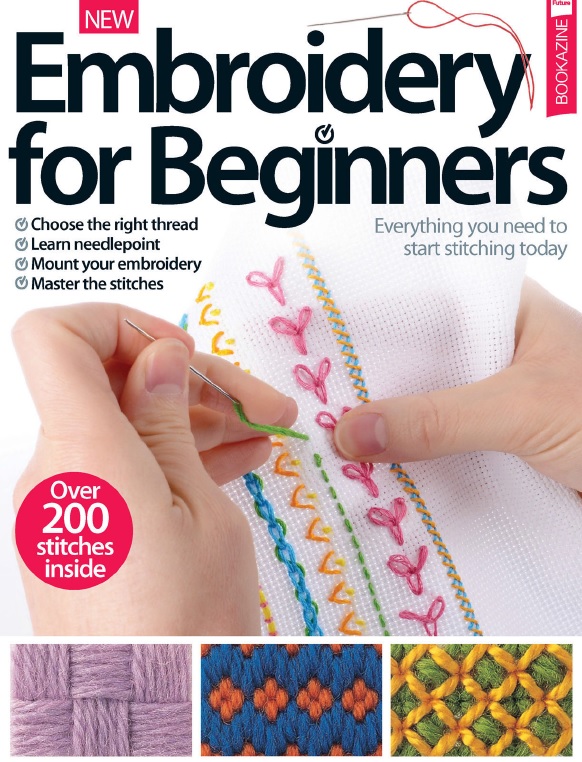
CONTENTS
Introduction 8
How to Use This Book 11
Materials, Tools, and
Techniques 12
Tools, Fabrics, Threads, and Frames
Mounting Techniques 19
Stitching Techniques 20
Gallery of Stitches 14
Line and Border
Stitches 38
Outline Stitches 40
Border Stitches 49
Composite Border Stitches 64
Openwork Stitches 92
Pulled Fabric Stitches 98
Drawn Thread and Insertion Stitches 106
Cutwork and Edging Stitches 113
Filling Stitches 72
Powdered Filling and Isolated
Stitches 74
Open and Solid Filling Stitches 86
Needlepoint Stitches 118
Straight Needlepoint Stitches 120
Diagonal Needlepoint Stitches 130
Cross and Star Needlepoint Stitches 140
Looped and Tied Needlepoint Stitches 152
Acknowledgments 160
Introduction
The art of embroidery has been defined simply as the ornamentation of textiles with decorative stitchery. It is an ancient craft which encompasses a wealth of history, and the same stitches are used by embroiderers throughout the world. They provide an international vocabulary that crosses the boundaries of land and time. Local patterns, designs, and ways of working vary from place to place, but the actual stitch techniques do not. The language of stitches is infinitely adaptable. It is being constantly reinterpreted by contemporary stitchers, who produce their new work as part of a continuing tradition.
INTERNATIONAL HERITAGE
Sewing was once an essential part of daily life for most women, and some men. Before mass production, many clothes and items of domestic furnishing had to be made at home and embroidery evolved as a means of decorating and personalising the plain needlework used for household linens and garments.
People in different countries concentrated on their own particular aspects of embroidery and names such as Bokhara couching, Antwerp edging, Portuguese border, and Algerian eye reflect the international aspect of the stitches they worked with. Creative concepts are always interchanged; patterns and ideas have travelled and developed throughout the world. German immigrants in Pennsylvania, for example, had to adapt their own traditional dense cross stitch patterns to outline-based designs, because of the shortage of embroidery threads in the New World.
TYPES OF STITCH
Embroidery stitches are worked on fabric, while needlepoint stitches are sewn on to canvas. Although there are hundreds of individual stitches used for both these techniques, they can be classified into just four groups, according to the way they are constructed: flat stitches which lie on the surface of the fabric; looped stitches, where one stitch is anchored by another; knotted stitches in which the thread is twisted back on itself to form a raised stitch, and openwork stitches which create a regular pattern of spaces, integrating the thread with the background fabric.
USING STITCHES
The various stitches within these four groups are endlessly adaptable and can be used in many ways, depending on the effect required. They can outline a design, be worked closely together so that they conceal the fabric completely, or be spaced further apart to allow the background to show through. Others may be used singly, repeated in rows, or stitched in a solid line. Certain stitches were developed for particular reasons. Gold thread is costly and too thick to pass easily through the fabric, so couching stitch was used to anchor it to the fabric with small stitches in fine thread. Turkey stitch evolved as an imitation of the cut pile of a rug, and insertion stitches were used as a means of joining two pieces of fabric.
One single stitch may be used throughout a piece of work. Rows of tent and cross stitches are used to create both samplers and embroidered pictures, while straight stitch can be used randomly like a painter’s brushstrokes to build up a textured, three-dimensional surface. It is when the patterns and shapes of the various stitches are combined, however, that their full potential is realised.
STITCH NAMES
For many centuries, knowledge of embroidery stitches was handed down as part of the wider folk tradition of needlecraft. It was not until 1631, when The Needle’s Excellency was printed, that their names began to be formalised in Europe. This was a book of patterns, not a practical manual, and there were no working diagrams or stitch illustrations. Some of the stitches listed – Fern-stitch, Chain-stitch, Back-stitch and the Crosse-stitch – are still in general use. Various other names were adopted over the following centuries. Some described the way in which the actual stitches were made, for example, twisted insertion and back stitch trellis. Others, such as cushion stitch, ladder stitch, window filling, and rope stitch, were named after the objects of daily life that they resembled. Still more were inspired by the surroundings of the natural world: star, wave, cloud, feather, coral, leaf, petal, and wheatear stitches.
Needlework was not valued as a separate area of study until the late nineteenth century. Under the influence of the Arts and Crafts Movement, designers interested in the history of stitching set about examining embroidered fabrics, and even unpicked old examples from across the world to discover how they had been worked. New historical texts and instruction books were written, and the format and names of stitches were standardised for the first time.
